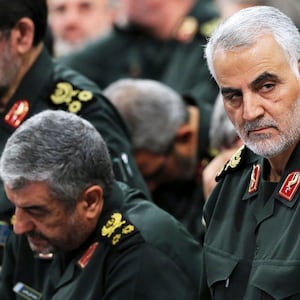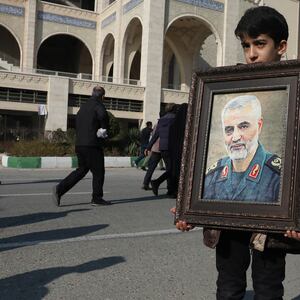In the five days prior to launching a strike that killed Iran’s most important military leader, Donald Trump roamed the halls of Mar-a-Lago, his private resort in Florida, and started dropping hints to close associates and club-goers that something huge was coming.
According to three people who’ve been at the president’s Palm Beach club over the past several days, Trump began telling friends and allies hanging at his perennial vacation getaway that he was working on a “big” response to the Iranian regime that they would be hearing or reading about very “soon.” His comments went beyond the New Year’s Eve tweet he sent out warning of the “big price” Iran would pay for damage to U.S. facilities. Two of these sources tell The Daily Beast that the president specifically mentioned he’d been in close contact with his top national security and military advisers on gaming out options for an aggressive action that could quickly materialize.
“He kept saying, ‘You’ll see,’” one of the sources recalled, describing a conversation with Trump days before Thursday’s strike.
ADVERTISEMENT
Trump’s gossipy whispers regarding a “big” response in Iraq foreshadowed what was to come. After hours of silence, senior officials in the Trump administration argued that what had taken place in Iraq was not an act of aggression. Instead, they said both publicly and behind closed doors on the Hill that killing Qassem Soleimani was designed to “advance the cause of peace,” as U.S. Special Envoy for Iran Brian Hook put it in a Friday interview.
Those Mar-a-Lago guests received more warning about Thursday’s attack than Senate staff did, and about as much clarity. A classified briefing on Friday, the first the administration gave to the Hill, featured broad claims about what the Iranians were planning and little evidence of planning to bring about the “de-escalation” the administration says it wants.
According to three sources either in the room or told about the discussion, briefers from the State Department, Pentagon, and the Office of the Director of National Intelligence claimed that killing Soleimani was designed to block Iranian plans to kill “hundreds” or even thousands of Americans in the Mideast. That would be a massive escalation from the recent attack patterns of Iran and its regional proxies, who tend to kill Americans in small numbers at a time.
“This administration has absolutely not earned the benefit of the doubt when it makes these kinds of claims. When you’re taking action that could lead to the third American war in the Middle East in 20 years, you need to do better than these kinds of assertions,” said a Senate aide in the room. Secretary of State Mike Pompeo has also said publicly that the Iranians planned to kill hundreds of Americans before Soleimani’s killing.
Nor, said four sources who requested anonymity to discuss a classified briefing, did the briefers provide detail on a key question surrounding an act of war against a regional power: what next?
Administration representatives didn’t provide specifics. Instead, they reiterated that the U.S. seeks to de-escalate tensions with Iran after killing one of its top military officials —a major emphasis for Pompeo in his calls to foreign dignitaries Friday. How the Trump administration plans to do that remains unknown, particularly now that the Pentagon confirmed the 82nd Airborne’s Immediate Response Force brigade will deploy to Kuwait. Administration officials provided instead “a vague expression of wanting to de-escalate but no clarity on what de-escalatory steps look like,” according to the Senate aide.
“To talk about de-escalation now is absurd, in a way, because Iran will react,” said Rob Malley, a senior Mideast official in the Obama White House. “The de-escalation decision should have been taken before the assassination of Qassem Soleimani.”
Iranian officials on Friday threatened the U.S. with a military response following the killing of Soleimani and Abu Mahdi al-Muhandis, the leader of the Iranian-backed Popular Mobilization Units militia in Iraq. It remains unclear exactly how Tehran will strike back, but current and former U.S. and Iraqi officials say Iran has a range of options at its disposal. And Tehran’s ability to strike doesn’t depend on Soleimani to lead the Quds Force, sources say.
“Soleimani was a bad guy, but it’s not like the [Quds Force] depended on him to operate,” said Jarrett Blanc, a former State Department official who worked on Iran policy. “The idea that the Quds Force had attacks in the works and now it doesn’t because he’s dead is obviously false. It’s not clear why killing Suleimani changes the threat profile.”
But on Friday, the Trump administration continued to portray the killing of a military commander of a country the U.S. is formally not at war with as an act that would lead to peace. In an interview with BBC radio, State Department official Brian Hook said the strike was “a very necessary thing to do.” And from a podium in Florida, Trump said the U.S. “took action last night to stop a war,” he said. “We did not take action to start a war.”
Then Vice President Mike Pence falsely suggested Iran was behind 9/11. Pence tweeted that Soleimani and his Quds Force “assisted in the clandestine travel to Afghanistan of 10 of the 12 terrorists who carried out the September 11 terrorist attacks in the United States.” Not only were there 19 attackers, but an incredulous ex-CIA counterterrorism analyst wearily noted that it “sounds like he’s directly tying Soleimani to 9/11.” The 9/11 Commission, as a different ex-CIA analyst tweeted, found that Iran had no advance knowledge of the attacks.
According to two sources familiar with the Senate briefing, another item of discussion was the prospect of Iraqi parliamentarians forcing the U.S. to withdraw–something they did in 2011 against the desires of a previous administration. But that isn’t the only major decision Iraqis have to take in the wake of the Soleimani and Muhandis killings.
An Iraqi official, speaking on background, told The Daily Beast that the strike on Thursday seriously complicates the already-arduous process of forming a new government after mass protests forced U.S.-backed Prime Minister Adil Abdul-Mahdi to resign in November. Abdul-Mahdi currently acts as a caretaker PM.
“At the very least, it furthers division in the country and raises the political temperature,” the Iraqi official said. “We need de-escalation and this is the mother of all escalations.”
Back at the Pentagon, spokeswoman Alyssa Farah portrayed the Soleimani killing as an “opportunity” for Iran “to turn from its terrorist past and cease its unlawful, aggressive escalatory attacks.”
In a statement summarizing the Senate briefing and a companion one in the House, Farah said the administration briefers made the point that “we do not seek escalation with Iran, and have taken appropriate measures to ensure the safety and security of U.S. citizens, forces, partners and interests in the region. They also reinforced our commitment to allies and partners in the region.”
Iran may have other plans. Ali Khedery, a hawkish former U.S. adviser in Iraq, expected the Quds Force to “aim to assassinate either a [CIA] station chief or an American flag officer, somewhere in the region.”
—with additional reporting by Sam Brodey










